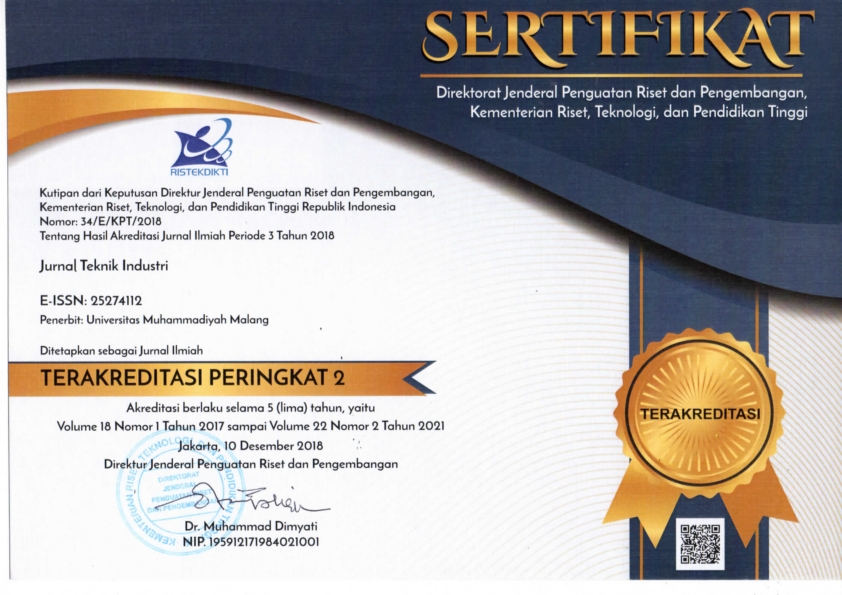Aplikasi Metode Taguchi Untuk Menurunkan Tingkat Kecacatan Pada Produk Paving
DOI:
https://doi.org/10.22219/JTIUMM.Vol16.No1.1-9Keywords:
Quality Control, Fishbone Diagram, Taguchi MethodsAbstract
Home Industry Putih Jaya is a company engaged in the paving blocks manufacturing which in producing paving certainly wanst to minimize any product defects. Known types of paving product that often occured is an easily cracked paving. An effort in the first stage to reduce the level of disability in this company is to identify the factors that affect product quality paving using fishbone diagram followed by the Taguchi method which is to determine the most influential factor and improve product quality paving so the defect rate can be decreased. From the data calculation with the fishbone diagram, there are six factors that influential. Among the six factors, those will be identified factor has the greatest influence resulting product quality deviates toward standards quality. Conclusion of the results showed that percentage of defect that occurs in the company initially around 4%, while by using the proposed improvement by Taguchi method decreases to 2%. The decreasing of defect percentage of defect means that the improvement of product quality is successfully. The factors the most influential factors to the paving is a drying process with the largest value of percent contribution in the amount of 34.5%.
Downloads
References
R. S. Kenett, "Cause‐and‐Effect Diagrams," Wiley StatsRef: Statistics Reference Online, 2014.
S.-Y. Tseng, S.-w. Tseng, and B.-s. Lin, "How To Improve The Haccp System In An International Tourist Hotel Group? Cause-And-Effect Analysis And Pdca Application," International Journal of Tourism & Hospitality Reviews, vol. 3, pp. 60-68, 2016.
D. C. Montgomery, Introduction to statistical quality control: John Wiley & Sons, 2007.
B. Gunawan, "Metode Taguchi Sebagai Salah Satu Alternatif Pengendalian Biaya Mutu," Jurnal Akuntansi dan Investasi, vol. 2, pp. 45-55, 2015.
Ş. Karabulut, "Optimization of surface roughness and cutting force during AA7039/Al2O3 metal matrix composites milling using neural networks and Taguchi method," Measurement, vol. 66, pp. 139-149, 2015.
G. S. Peace, Taguchi methods: a hands-on approach: Addison Wesley Publishing Company, 1993.
I. Soejanto, Desain Eksperimen dengan Metode Taguchi. Yogyakarta: Graha Ilmu, 2009.
J. Pang, M. Ansari, O. S. Zaroog, M. H. Ali, and S. Sapuan, "Taguchi design optimization of machining parameters on the CNC end milling process of halloysite nanotube with aluminium reinforced epoxy matrix (HNT/Al/Ep) hybrid composite," HBRC Journal, vol. 10, pp. 138-144, 2014.
K. Pawar and R. Palhade, "Multi-objective Optimization of CNC Turning Process Parameters for High Speed Steel (M2) Using Taguchi and ANOVA Method," International Journal of Hybrid Information Technology, vol. 8, pp. 67-80, 2015.
Y. T. Chung, M. M. Ba-Abbad, A. W. Mohammad, N. H. H. Hairom, and A. Benamor, "Synthesis of minimal-size ZnO nanoparticles through sol–gel method: Taguchi design optimisation," Materials & Design, vol. 87, pp. 780-787, 2015.











